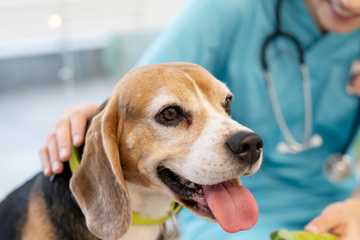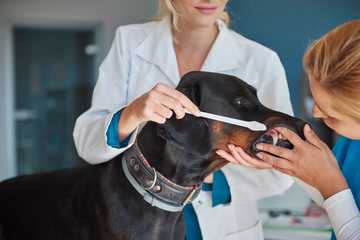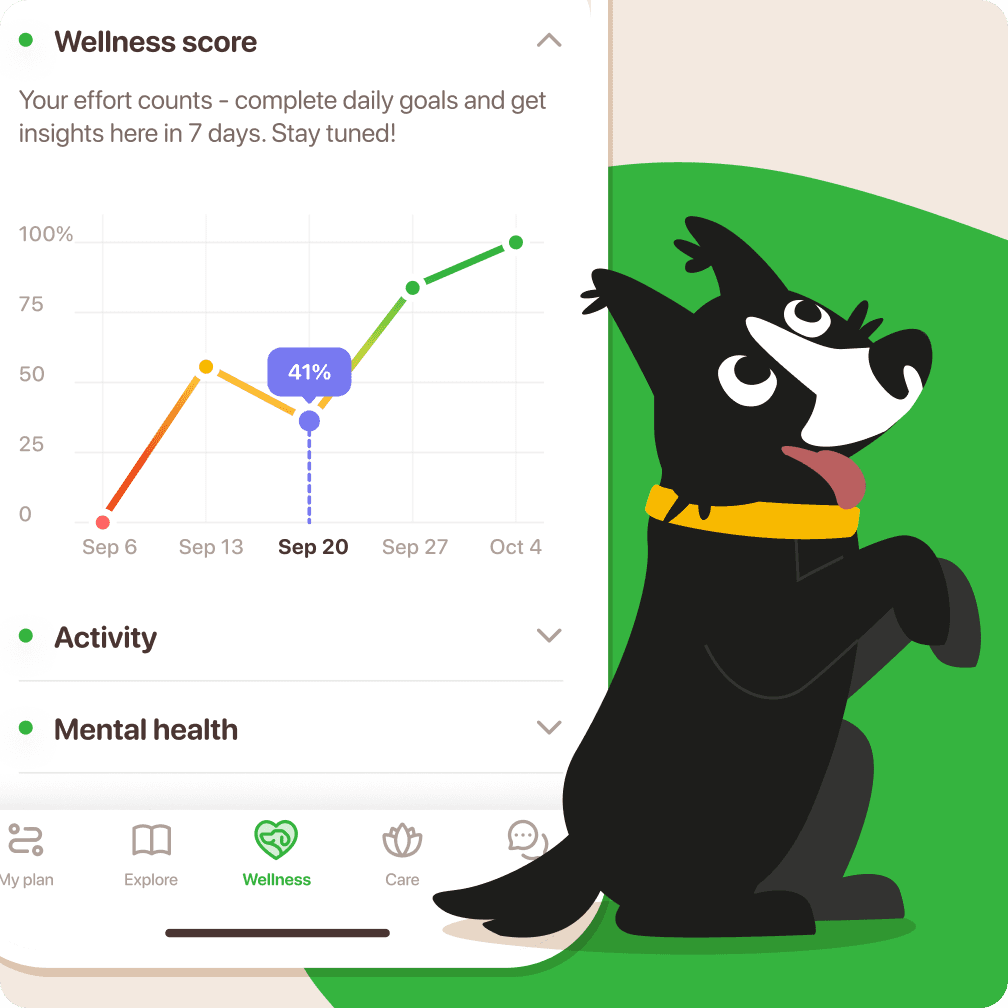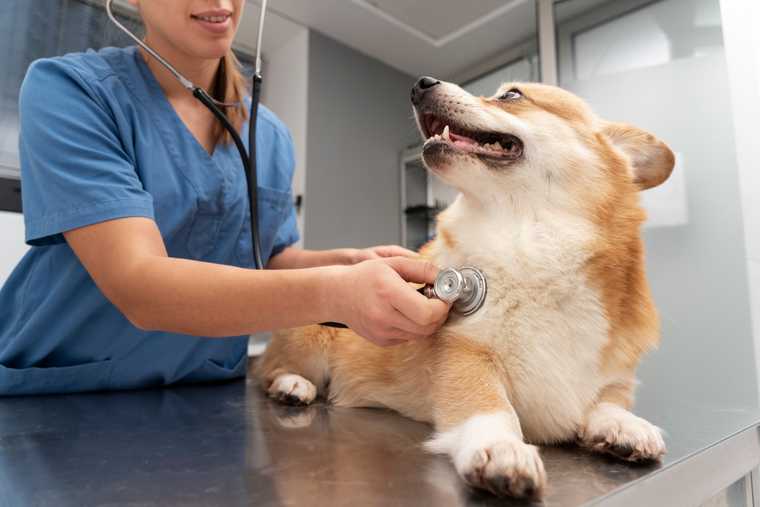Wellness Check for Dogs: All Need to Know

By
Anastasiia Petrovska Updated on |Reviewed by Shannon Kenny
Key Takeaways
- Dog wellness exams are a type of preventive care
- The exam covers: medical history and physical examination, vaccinations and parasite control, dental health, and nutritional assessment
- Preparation for a wellness exam is key to a thorough test
A dog's wellness exam or a wellness check-up is a type of essential health service. It’s a preventive check-up that helps to keep track of a pet's health and detect diseases early. Whether it’s a puppy wellness check or a timely treatment for your senior dog, knowing the process can make a difference in their care.
What Is a Wellness Exam for Dogs?
A wellness exam for dogs is a routine veterinary appointment. It’s aimed at preventing an illness, rather than treating an existing medical problem. In other words, it’s a proactive exam of a healthy dog, rather than an examination of an ill dog.

During this check-up, a dog owner and a vet will discuss the pet's overall health. This includes:
- Discussing the pet’s lifestyle and behavior
- Diet and activity
- Performing a thorough physical examination.
The aim is to make sure the dog is well and take preventive measures, such as parasite control and vaccinations, on time.
Pet Wellness: How Often Do Dogs Need Check-ups?
Determining how often dogs need check-ups depends on several factors, including:

- Age
- Breed
- General health
- Presence of chronic conditions.
According to information provided by the VCA Animal Hospitals:
-
Puppies under 16 weeks need regular wellness exams every 3–4 weeks during puppyhood. After 16 weeks, health check-ups should be every couple of months. This allows vets to observe puppy development and adhere to vaccination schedules.
-
Adult dogs are expected to have annual wellness exams.
-
Senior dogs need a wellness check-up twice a year. They’re considered to be a vulnerable group more prone to health issues that benefit from early detection.
-
Dogs with chronic conditions may require a more frequent schedule for health check-ups, such as every 3–6 months. However, the exact number of health visits will depend on the vet’s recommendations and the dog’s condition.
What Does a Dog Wellness Exam Consist Of?
A standard pet wellness exam typically consists of the following:
Medical History
The vet usually asks questions concerning the pet’s overall well-being, including:

- The dog’s breed and activity level
- Diet and behavior changes.
- Urination/defecation habits
- Previous illnesses or surgeries (may request access to health records)
- Medications or supplements.
Sometimes what looks like disobedience is actually discomfort. A wellness check can rule out pain or medical causes before you start working on any training challenges.
It’s an essential first step of the exam that helps to identify any potential illness or risk factors.
Physical Examination
A physical exam in the clinic is a crucial step of the wellness check-up. According to Madison Park Veterinary Hospital, during this part, the vet runs tests to check:

- Skin and coat
- Eyes, ears, mouth, and teeth
- Lymph nodes
- Mobility
- Abdomen
- Heart and lungs
- The dog’s weight.
A physical examination is essential for detecting any hidden disease.
Vaccinations
The veterinarian will review your pet’s vaccination status based on the breed, age, and presence of regional risk factors. It’s a standard, yet crucial part of your dog’s wellness exam. Vaccinations are irreplaceable in protection against contagious diseases.
Parasite Control
Another key component of the pet’s wellness exam is parasite prevention. This includes checking for fleas, ticks, heartworm, and intestinal parasites. A dog owner and a vet will likely discuss an ongoing parasite control strategy based on the dog’s specific environment.
Dental Health
A dog's dental health is often overlooked. It’s part of a health check-up, during which your vet evaluates the following:

- The state of the teeth and gums
- Signs of gingivitis
- Presence of loose teeth
- Signs of periodontal disease.
Dental health is a vital part of a dog's overall wellness, as it can cause systemic diseases if left untreated.
Nutritional Assessment
Reviewing your pet’s diet and feeding habits is essential to preserving your dog’s health. The vet will check your pet’s weight and provide recommendations in case your dog is underweight or overweight. They can also address a dog's specific dietary needs according to the following:
- Age
- Breed
- Activity level
- Presence of allergies.
Remember: good, well-balanced nutrition supports the immune system, coat health, and energy levels.
Additional Tests
Depending on the dog’s age, health issues, or exam findings, your vet may recommend undergoing additional testing. These include:
- Blood work
- Urinalysis
- X-ray
- Ultrasound
- Parasite test.

These are basic preventive tests that are needed to monitor your dog’s overall health. They’ll also help to detect disease before any clinical signs are present. Early detection of the disease often means better outcomes and lower cost of the treatment.
How Much Is a Pet’s Wellness Exam?
The answer to the question “How much is a wellness exam for a dog?” is common: it depends. The exact price depends on location, a dog’s age and health status, as well as health tests that need to be performed. Above that, if a hospital belongs to a well-known brand like Banfield Pet Hospital, the price for a dog wellness exam can go higher. Explore the breakdown of costs for a wellness check-up for dogs in the USA, Great Britain, and Europe.
| Region | Average Cost (USD) |
|---|---|
| US (USD) | $50–175* |
| Great Britain (USD) | $65–110* |
| Europe (USD) | $65–110* |
*The prices presented in the table represent the average cost of a simple wellness exam. The final cost may be different and depends on the additional health services included in the check-up.
Dog’s Health: Find Help in Your Smartphone
The wellness exam happens once in a while, but you use your phone every day. Mobile apps are a good tool to monitor your pet’s health without reaching out to the vet. The Woofz app recently introduced a Wellness Dashboard to its regular wellness check.

With the help of this tool, pet parents can monitor a dog's health at home between vet visits. By tracking 5 key wellness areas, the app allows you to spot any early changes and talk to the vet immediately if something seems off.
6 Key Steps on How to Prepare for a Dog’s Wellness Exam
Preparing for your dog’s wellness exam helps you and your pet get the most from it. It ensures the vet receives all the information needed for a thorough check-up. Use the following 6 steps to prepare.
1. Gather Information
Before an exam, make sure to prepare information about:
- The dog’s age and breed
- Health history, including past surgeries
- Medications and/or supplements
- Vaccinations
- Diet and water intake
- Behavioral changes
- Activity
- Potty routine.
A vet may ask you all of the above, so make sure to keep all of this information.
2. Observe Pet’s Behavior
Observe your dog’s behavior a few days before the day of the vet visit. Note any changes in energy levels, appetite, coat condition, urination, defecation, as well as mobility. In case of medical problems, such observations may give a clue to your pet's health.

3. Make a List of Questions
If you have any concerns about your pet’s health, make a list of questions. Cover the following:
- Breed-associated health risk
- Changes in the pet’s behavior
- Dental health
- Upcoming vaccinations.
Ask about any medical tests you may want to do, their availability, price, and validity. Preparing a list of questions beforehand helps to keep the information organized. It also ensures you don't forget anything crucial during a vet visit.
4. Train for Handling
Take some time to train handling, especially if your dog isn’t used to such situations. Practice lifting the paws gently, opening the mouth, and staying seated for a short time. Such simple training sessions help to reduce stress and make the visit more comfortable for the dog.
As a trainer, I always encourage owners to think of wellness visits as part of their training routine. A dog who’s comfortable being handled by a vet or groomer is a dog who feels safer and more confident in new situations.
5. Take Dog’s Comfort Food
High-value treats and your dog’s favourite comfort items are a must to take with you. It’ll help to comfort your dog if the vet's office is a stressful experience.
6. Bring Test Samples
Sometimes, while arranging a visit to a vet clinic, a veterinarian may ask to bring some test samples. These can be a fecal sample and/or a urine sample, depending on what you’re asked for.
Wrap Up
A timely and well-conducted wellness exam is the foundation of a dog’s preventive healthcare. Understanding what a wellness check is and how to prepare for it makes you a responsible pet parent. The Woofz App and its Wellness Score are a supportive tool that can help you keep track of your pet’s well-being.
Monitoring key areas of health can help identify health issues earlier. Thoughtful home monitoring and regular vet check-ups ensure your dog lives a joyful, healthy life.
